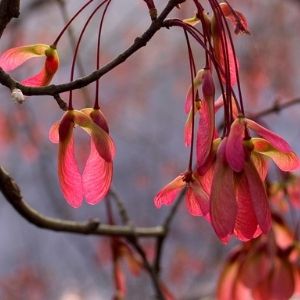
Aptly named red maple (Acer rubrum)- Acer meaning maple and rubrum meaning red- the common and Latin names both refer to the many parts of the tree that are red in colour, including its flowers, fruit, twigs and fall foliage. Each of these stunning “red” attributes can be seen on the red maple at different times throughout the year.
In late winter to early spring, before the leaves emerge, small, hanging clusters of bright red male and female flowers appear. These early blooms provide an important food source for native pollinators, such as mason bees and bumblebees, who consume the nutrient rich nectar and pollen. 
Following the flowers, small, reddish-brown clusters of two-winged, papery, horseshoe-shaped fruits, called samaras, emerge and ripen in the late spring to early summer. This early fruit emergence is a trait only shared with the native silver maple (Acer saccharinum) as the fruit of all other native maples emerges in the fall. Often called maple keys or helicopters, the samaras are borne on long, slender stems and hold seeds that are favoured by small wildlife, including squirrels, chipmunks and rabbits, as well as songbirds, such as the red-breasted nuthatch, purple finch and evening grosbeak.

Throughout the summer months, the red maple shows off its simple, bright green foliage. The leaves are rounded with three-to-five shallow lobes and serrated edges, providing an essential food source for the native rosy maple moth, maple looper moth and cecropia moth. From September to November, the foliage can turn anywhere from a pale yellow to orange to a flaming, scarlet red colour. However, it’s important not to confuse this native species with the red-leaved cultivars of the Norway maple (Acer platanoides), which are non-native and invasive.

Ultimately, the outstanding multi-seasonal characteristics of the red maple make it a sought after tree. If you are looking to plant a multi-seasonal tree in your yard, visit our website to set up a consultation with one of our arborists this spring!
Brenna Anstett is an ISA certified arborist and the Residential Planting Programs Manager at LEAF.
LEAF offers a subsidized Backyard Tree Planting Program for private property. The program is supported by the City of Toronto, the Regional Municipality of York, the City of Markham, the Town of Newmarket, the Regional Municipality of Durham, the Town of Ajax, the City of Oshawa, the City of Pickering, the Township of Scugog, the Town of Whitby, Ontario Power Generation, Ontario Trillium Foundation and GrandTrees/Canadian Trees For Life.
